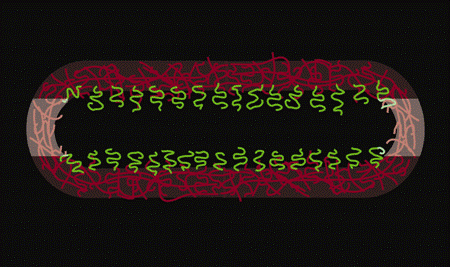A research team led by Javid Rzayev, who serves as Assistant Professor of Chemistry at the University at Buffalo has developed small molecular cages that are capable of trapping and purifying nanoparticles.
 An illustrated cross-section of a nanotube UB chemists created. The green structures are negatively charged carboxylic acid groups, which help trap positively charged particles.
An illustrated cross-section of a nanotube UB chemists created. The green structures are negatively charged carboxylic acid groups, which help trap positively charged particles.
The traps made of bottle-brush molecules, a unique type of molecule synthesized by the team, comprises small, organic tubes with negatively charged interior walls that make the cages to selectively capture particles with a positive charge. These traps find applications in screening proteins by charge and size and separating small quantum dots from large quantum dots in the future.
The research team built the core of each bottle-brush molecule utilizing molecular forms that crumble at the moment when they contact with water. The team then surrounded the core with a layer of carboxylic acid groups, which have a negative charge. When submerged in water, the bottle-brush molecule’s core hollowed out to form a nanotube with interior walls having a negative charge due to the carboxylic acid groups.
In order to demonstrate the cages’ efficiency as traps, the research team conducted a sequence of tests using a two-layered chemical cocktail, whose top layer comprised an aqueous solution consisting of positively charged dyes and its bottom layer comprised a chloroform solution comprising the nanotubes. When the cocktail was subjected to shaking for five minutes, the collision between the nanotubes and the dyes occurred, resulting in the transfer of the dyes from the aqueous solution into the chloroform solution.
In a similar manner, the research team segregated dendrimers, which are positively charged molecules, from water-based solution. The team designed the nanotube in such a way that it traps dendrimers having 2.8 nm of diameter, while leaving dendrimers having 4.3 nm of diameter. In order to release the trapped dendrimer particles from the nanotubes, the team reduced the chloroform solution’s pH, which nullifies the traps’ negative charge and releases the trapped particles.